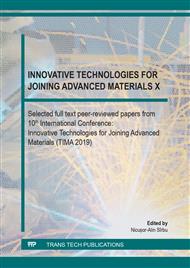p.113
p.123
p.130
p.136
p.142
p.149
p.154
p.161
p.168
Mechanical Testing of GFRP Composite Materials Used in Wind Turbine Blades Construction
Abstract:
The paper proposes to present the results of the evaluation of glass fiber reinforced plastics (GFRP) used in the construction of wind turbine blades. In a wind turbine, the blades are the most exposed to damages and the defects which appear are various and are connected with the type of manufacture, simple/complex loading, environmental conditions etc. In order to increase the lifetime span and to analyze the degradation phenomena during the materials functioning, destructive evaluation tests are performed to determine the mechanical property, by testing pure shear on specimens Iosipescu, from GFRP with woven reinforcement at [± 45°] and [0°/90°], with the shear fixture, endowment of Technical University Gh.Asachi Iasi.
Info:
Periodical:
Pages:
142-148
Citation:
Online since:
February 2020
Price:
Сopyright:
© 2020 Trans Tech Publications Ltd. All Rights Reserved
Share:
Citation:


